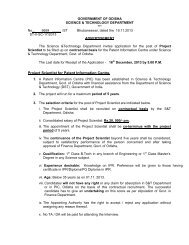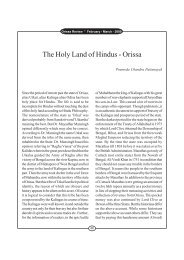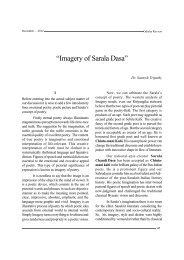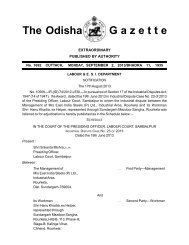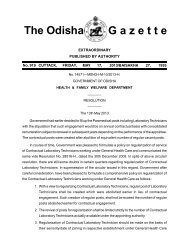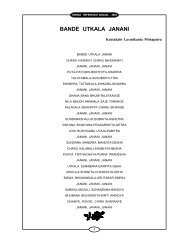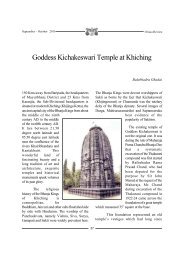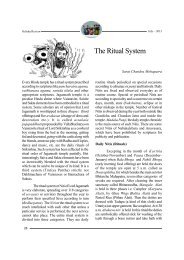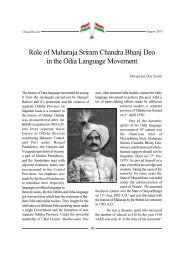Lord Shree Jagannath - a Great Assimilator of Tantric Impressions ...
Lord Shree Jagannath - a Great Assimilator of Tantric Impressions ...
Lord Shree Jagannath - a Great Assimilator of Tantric Impressions ...
You also want an ePaper? Increase the reach of your titles
YUMPU automatically turns print PDFs into web optimized ePapers that Google loves.
day Sambalpur) which is amply proved from<br />
the seats <strong>of</strong> the idols which are Yantras <strong>of</strong> various<br />
type. <strong>Lord</strong> Shri <strong>Jagannath</strong> sits on Kali Yantra,<br />
Balabhadra on Tara-yantra, Subhadra on<br />
Bhubaneswari - Yantra and the Mantras adopted<br />
for their worship should also be studied. Though<br />
these Mantras have been widely corrupted by<br />
subsequent additions and interpolations, the basic<br />
Vija Mantras appear to be <strong>Tantric</strong> and not Vedic.<br />
The <strong>Lord</strong> Shri <strong>Jagannath</strong> is worshipped by the<br />
following Mantra. “Klim Krishnaya, Govindaya<br />
Gopijana Vallabhaya Svaha”. It is undoubtedly a<br />
fact that except the primary vija Mantra ‘Klim’,<br />
the other portion <strong>of</strong> the Mantra is a Chaitanitic<br />
addition whose creed overwhelmed the then<br />
Oriya religious thoughts and culture due to royal<br />
patronage at the time <strong>of</strong> Gajapati king Pratap<br />
Rudra Dev and naturally the seat <strong>of</strong> Oriya Culture,<br />
i.e, Shri <strong>Jagannath</strong> <strong>of</strong> Puri adopted the religion <strong>of</strong><br />
the king with consequential changes.<br />
What is this ‘Klim’ which is the Vija<br />
Mantra for worship <strong>of</strong> <strong>Lord</strong> Shri <strong>Jagannath</strong>?<br />
Actually, Klim is the Vija Mantra <strong>of</strong> Sakta Tantrik<br />
Deity Kali and very <strong>of</strong>ten <strong>Lord</strong> Shri <strong>Jagannath</strong><br />
has been described as ‘Dakshina Kalika’ (in<br />
‘Mahanirvana Tantra’).<br />
Influence <strong>of</strong> <strong>Tantric</strong> way <strong>of</strong> Puja in case<br />
<strong>of</strong> <strong>Lord</strong> Shri <strong>Jagannath</strong> can be well observed from<br />
various Nyasas such as “Sadanga-Nyasa”,<br />
“Keshavadi Nyasa”, “Shrikanthadi Nyasa”,<br />
“Kala-Nyasa”, “Matruka-Nyasa”, “Sodha-<br />
Nyasa” and “Mahasodha Nyasa” which are<br />
attributed in daily mode <strong>of</strong> worship <strong>of</strong> <strong>Lord</strong> Shri<br />
<strong>Jagannath</strong>.<br />
Moreover, “Panchasakhas” (five friends),<br />
i.e., Balaram Das, Ananta Das, Yasobanta Das,<br />
Achyutananda Das and <strong>Jagannath</strong> Das are all<br />
Vaishnavites and their presiding Deity is Shri<br />
<strong>Jagannath</strong> <strong>of</strong> Puri, Purusottam Khetra. But they<br />
are all devotees <strong>of</strong> <strong>Lord</strong> Shri <strong>Jagannath</strong> in a <strong>Tantric</strong><br />
July - 2011<br />
Orissa Review<br />
mode (i.e., Kaula- charies). We find mention <strong>of</strong><br />
Yantra, Mantra and Tantra in their literatures.<br />
According to them, <strong>Lord</strong> Shri <strong>Jagannath</strong> is both<br />
“Saguna Brahma” and “Nirguna Brahma”. Yantra,<br />
Mantra, Tantra are nothing but “Saguna Sadhana”.<br />
According to them, one can realise Shri <strong>Jagannath</strong><br />
in his own body by both Saguna Sadhana and<br />
Nirguna Sadhana which is famous as “Pinda -<br />
Brahmanda Tatwa or Theory” which has been<br />
delineated in earlier paragraphs.<br />
Besides, the following daily rituals would<br />
show that the articles <strong>of</strong>fered to the <strong>Lord</strong> are<br />
symbols <strong>of</strong> five M’s <strong>of</strong> the Tantra Dakshinachara<br />
worship. In the morning, cocoanut water is <strong>of</strong>fered<br />
to <strong>Lord</strong> Shri <strong>Jagannath</strong> and Madan Mohana<br />
(moveable representative Deity <strong>of</strong> Shri <strong>Jagannath</strong>)<br />
in a Kansya-Patra, i.e bell metal pot or water with<br />
Jaiphala thrashing in an earthen pot as a symbol<br />
<strong>of</strong> wine. This is also <strong>of</strong>fered during day’s <strong>of</strong>fering<br />
<strong>of</strong> Panktibhoga. Similarly <strong>of</strong>fering <strong>of</strong> black gram<br />
(biri) cakes admixtured with Hengu is made as a<br />
symbol <strong>of</strong> flesh <strong>of</strong>fering. Offering <strong>of</strong> various green<br />
Sakas (lettuce) with ginger (ada) and ‘hengu’ are<br />
made as a symbol <strong>of</strong> fish. Offering <strong>of</strong> various<br />
cereals are made as symbol <strong>of</strong> Mudra. At times,<br />
Mudra is identified with various gestures <strong>of</strong> hand<br />
while <strong>of</strong>ferings are made to the Deity. The last<br />
<strong>Tantric</strong> symbol <strong>of</strong> worship is Maithuna or<br />
copulation. This may appear odd but, it was<br />
symbolically represented by Mahari or Devadasi<br />
dances (till 1956) in the Shri <strong>Jagannath</strong> Temple at<br />
the time <strong>of</strong> sleep <strong>of</strong> the <strong>Lord</strong> at night. These dances<br />
were <strong>of</strong>fered to the <strong>Lord</strong> by an unmarried girl in a<br />
semiclad body in a trance position. The system is<br />
no more prevalent, as no unmarried girl is<br />
available who would remain unmarried for whole<br />
life in order to perform Devadasi Nrutya before<br />
<strong>Lord</strong> Shri <strong>Jagannath</strong> alone. Even <strong>Lord</strong>s are<br />
dressed like women by wearing Saries with veils<br />
head dresses <strong>of</strong> women and nose-rings at the time<br />
<strong>of</strong> worship.<br />
57



